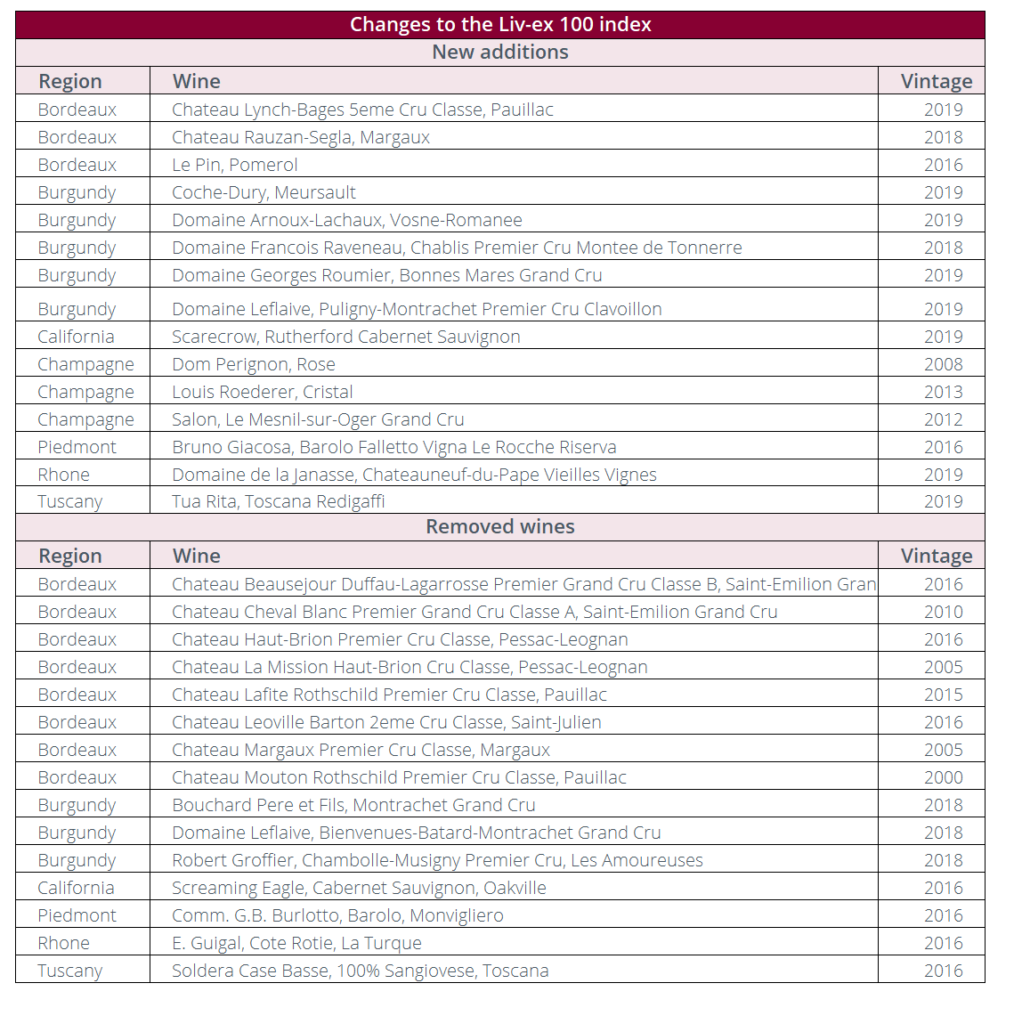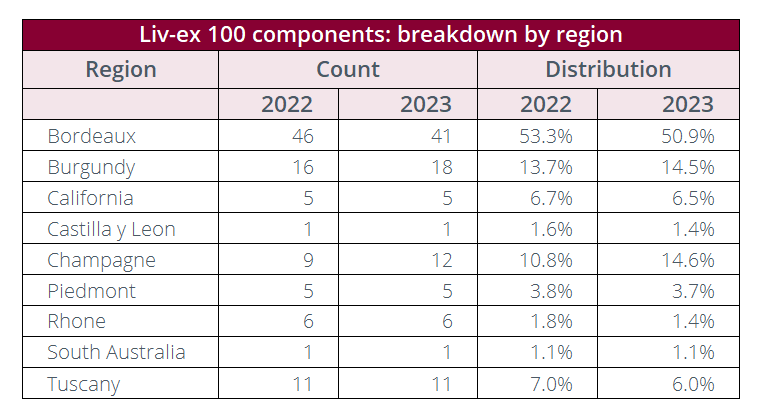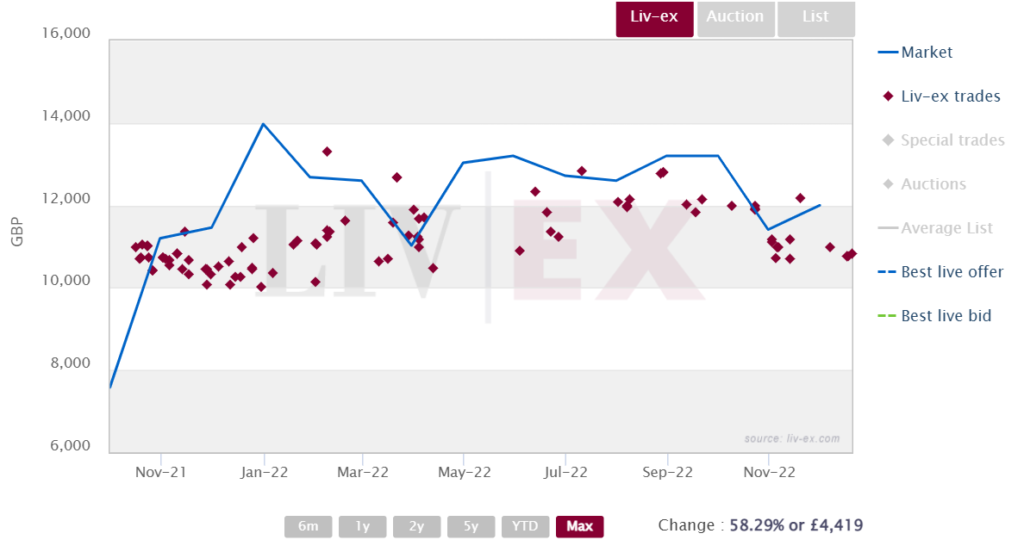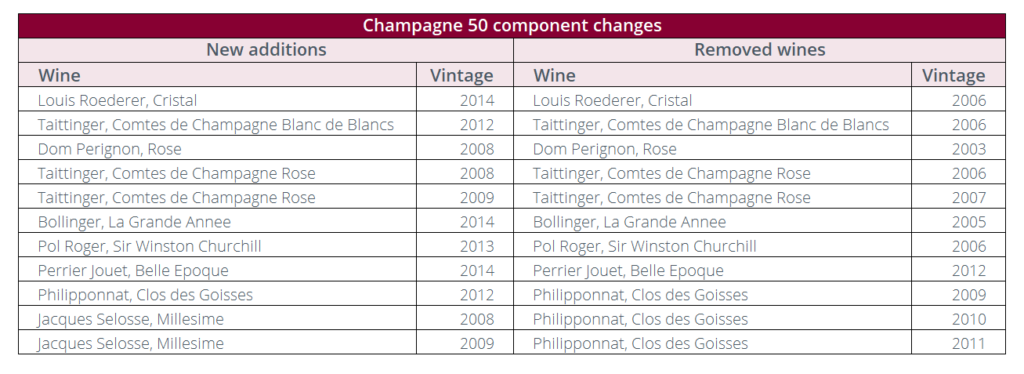- The Liv-ex 100 and Liv-ex 1000 indices will feature new wines from January 2023.
- The changes reflect the growing presence of Burgundy and Champagne in the secondary market and shifting patterns within Bordeaux and the rest of the world.
- Within the Liv-ex 1000 index, Burgundy and Italy have seen the highest number of changes.
The London International Vintners Exchange (Liv-ex) has been reporting on the actual trading activity of the largest global network of reputable wine merchants for over 20 years. Their bids, offers and trades are used to produce the Liv-ex indices – considered the benchmark by Bloomberg, Refinitiv and most reputable wine and financial news outlets. The data is independent, coming direct from the market.
Upcoming changes to the Liv-ex indices
To ensure that the Liv-ex indices accurately reflect the wine market, their components are revised annually: older and low liquidity wines are pushed out to make room for more active wines.
To qualify, wines must have critical acclaim, be physically available on the market (wines trading En Primeur are excluded) and attract regular demand on Liv-ex.
This article examines the upcoming changes to the Liv-ex Fine Wine 100 index (the industry benchmark) and the Liv-ex Fine Wine 1000 index (our broadest measure of the market) in the context of the past year.
The current component wines of each index can be downloaded here. They will be updated with the new wines at the end of the month.
The Liv-ex 100 index

The growing importance of Champagne and Burgundy in the secondary market
Burgundy and Champagne were the leading regions in 2022, with the biggest price rises and largest trade share gains. While Bordeaux’s share hit a new annual low at 34.7% of total trade by value, Burgundy and Champagne registered new highs at 25.9% and 13.6% of the market respectively.
The growing secondary market of the two regions will be reflected in the industry benchmark index. The most noticeable change in the Liv-ex 100 index is the addition of three Champagnes and five new Burgundy labels. The new additions are largely at the expense of Bordeaux, which has had five wines removed from the industry benchmark. Although three Burgundy wines have also been removed.

The new Champagnes in the Liv-ex 100 are Dom Pérignon Rosé 2008, Louis Roederer Cristal Rosé 2013 and Salon Le Mesnil-sur-Oger Grand Cru 2012.
Salon Le Mesnil-sur-Oger Grand Cru 2012 trades on Liv-ex

The Liv-ex 1000 index
Within the Liv-ex 1000, the Champagne 50 sub-index is also undergoing changes to its components. Apart from the vintage rollover, Jacques Selosse Millessime is joining the index with its 2008 and 2009 vintages, while the number of Philipponnat Clos des Goisses wines is going down from four to two.

Other regional changes
However, the biggest changes within the Liv-ex 1000 index are for Burgundy 150 and Italy 100 sub-indices.
Among the Burgundian reds, Domaine des Lambrays Clos des Lambrays Grand Cru is replacing Domaine Ponsot Clos de la Roche Grand Cru Cuvee Vieilles Vignes. Among the whites, Coche-Dury Meursault is taking the place of Bouchard Pere et Fils Montrachet Grand Cru.
The new wines in the Italy 100 are Bruno Giacosa Barolo Falletto Vigna Le Rocche Riserva and Fontodi Colli della Toscana Centrale Flaccianello delle Pieve, replacing Giacomo Conterno Barolo Francia and Soldera Case Basse 100% Sangiovese.
Château Rayas, which rose in the 2022 Power 100 rankings thanks to strong price performance, is also joining the Rhône 100 index, while Vieux Telegraphe La Crau Rouge is leaving.
Seña joins the Rest of the World 60
Within the Rest of the World 60 index, Chilean brand Seña is replacing Taylor’s Vintage Port. Recent Seña vintages have received high scores from major critics like The Wine Advocate’s Luis Gutiérrez and James Suckling, who both awarded 100-points to its 2018 and 2015 vintages. Moreover, the wine led Chilean trade by both value and volume last year. Its most sought-after vintages in 2022 were 2017 and 2019.
About Liv-ex Indices
The Liv-ex Fine Wine indices track the prices of the most traded fine wines in the world. The indices are calculated using the Liv-ex Mid Price, which refers to the mid-point between the highest live bid and lowest live offer on the market. The prices are validated against additional data including transaction prices and are the most robust measure for pricing wines available in the market.
The industry leading benchmark, the Liv-ex Fine Wine 100 index, represents the price movement of 100 of the most sought-after fine wines on the secondary market from France, Italy, USA, Australia and Spain.
The Liv-ex Fine Wine 1000 index is the market’s broadest measure. It represents the price movement of 1,000 wines from across the world. The index comprises seven sub-indices: the Bordeaux 500, the Bordeaux Legends 40, the Burgundy 150, the Champagne 50, the Rhône 100, the Italy 100 and the Rest of the World 60.
Not a member of Liv-ex? Request a demo to see the exchange and a member of our team will be in touch with you shortly.
Liv-ex analysis is drawn from the world’s most comprehensive database of fine wine prices. The data reflects the real time activity of Liv-ex’s 600 merchant members from across the globe. Together they represent the largest pool of liquidity in the world – currently £80m of bids and offers across 16,000 wines.





